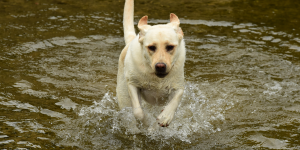Blue-Green Algae And The Danger to Dogs.
Many people may have heard of the dangers of blue-green algae which appears in puddles, ponds, lakes and rivers at certain times of the year. But, what exactly is it and what are the dangers to pet dogs? Holidays4Dogs explains why dog owners need to be aware of blue-green algae when walking their dogs near water.
Blue-green algae, or ‘cyanobacteria’, is actually a naturally occurring type of bacteria. It has the appearance of algae when it forms as a mass in water courses. It usually forms when the weather begins to get warmer in the spring and summer months.
Where does blue-green algae bloom?
The algae is commonly found in bodies of still water such as puddles, ponds and lakes – or, indeed, any water that is still, stagnant, or flows slowly. While it is less common in fast flowing rivers, it can still form if the river flows gently. Blue-green algae can also form in areas where land has flooded and the water has stood for some time.
This type of algae can be highly toxic to humans, and dogs, if water contaminated by bacteria is ingested. This can happen while swimming in water affected by the algae. Blue-green algae, in bodies of water where dogs swim, can pose a danger.
What to look out for.
It isn’t possible to see blue-green algae until it has begun to clump together, forming masses. When this happens, it can then be visible on the surface of the water. It can look bluish-green – as the name implies – but can also appear as a brownish clump.
Sometimes it has the appearance of seaweed floating on the water. It can also look like flakes and will often turn the surrounding water cloudy with a blue, green, or brown hue.
It can also look like flakes and will often turn the surrounding water cloudy with a blue, green, or brown hue.
It may also look like pollution in appearance, or as a foamy substance on the edge of a shoreline.
Not all blue-green algae are toxic, but there is absolutely no way of distinguishing whether it is, or not.
Blue-green algae can pose an unseen danger to dogs. Therefore, it is safer to keep your dog well away from water which might be contaminated with algae.
Symptoms/treatment of blue-green algae poisoning.
- Vomiting
- Drooling
- Thirst
- Difficulty with breathing
- Seizures
- Collapse, or even sudden death.
If you suspect your dog has ingested contaminated water, it is important to get your dog to a vet as soon as possible. The quicker your dog is treated, the better the outcome will be. While there is no treatment available to reverse the effects, your dog may need intensive care to support his organs from potential damage.
Reporting blue-green algae.
The dangers of blue-green algae to dogs are very real. Therefore, in order to protect your dog from the effects of blue-green algae, never let him drink from open water, or swim in bodies of water that might contain bacteria.
order to protect your dog from the effects of blue-green algae, never let him drink from open water, or swim in bodies of water that might contain bacteria.
Many local authorities will monitor certain areas for the presence of algae and put up notices accordingly.
However, do not rely on this as evidence of the safety of a given stretch of water. If you think you see water which may contain blue-green algae you can report it to the Environment Agency on 0800 80 70 60.


